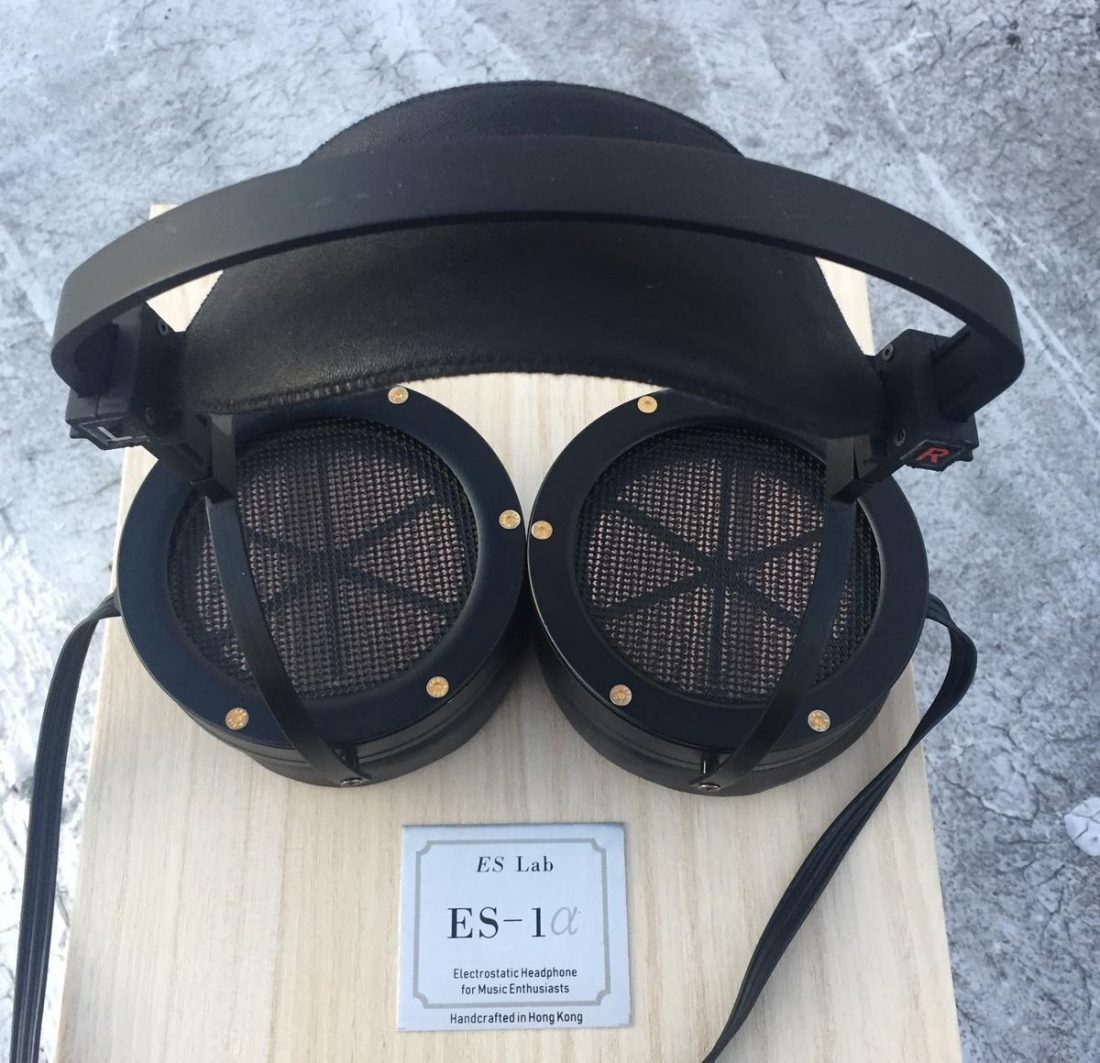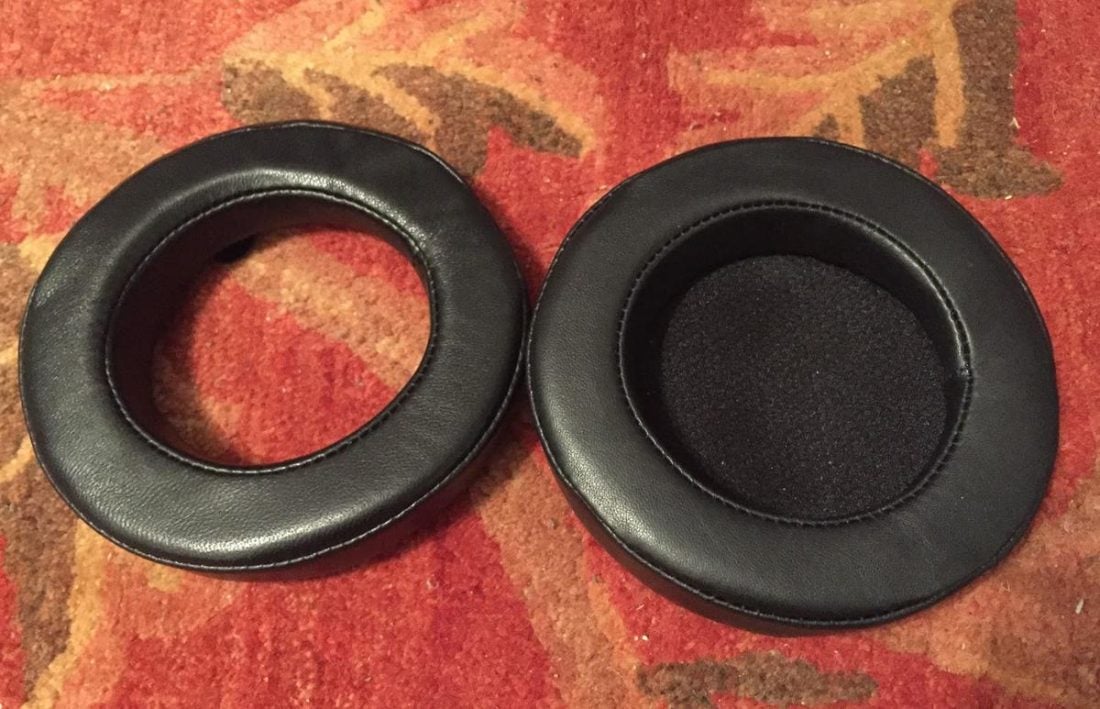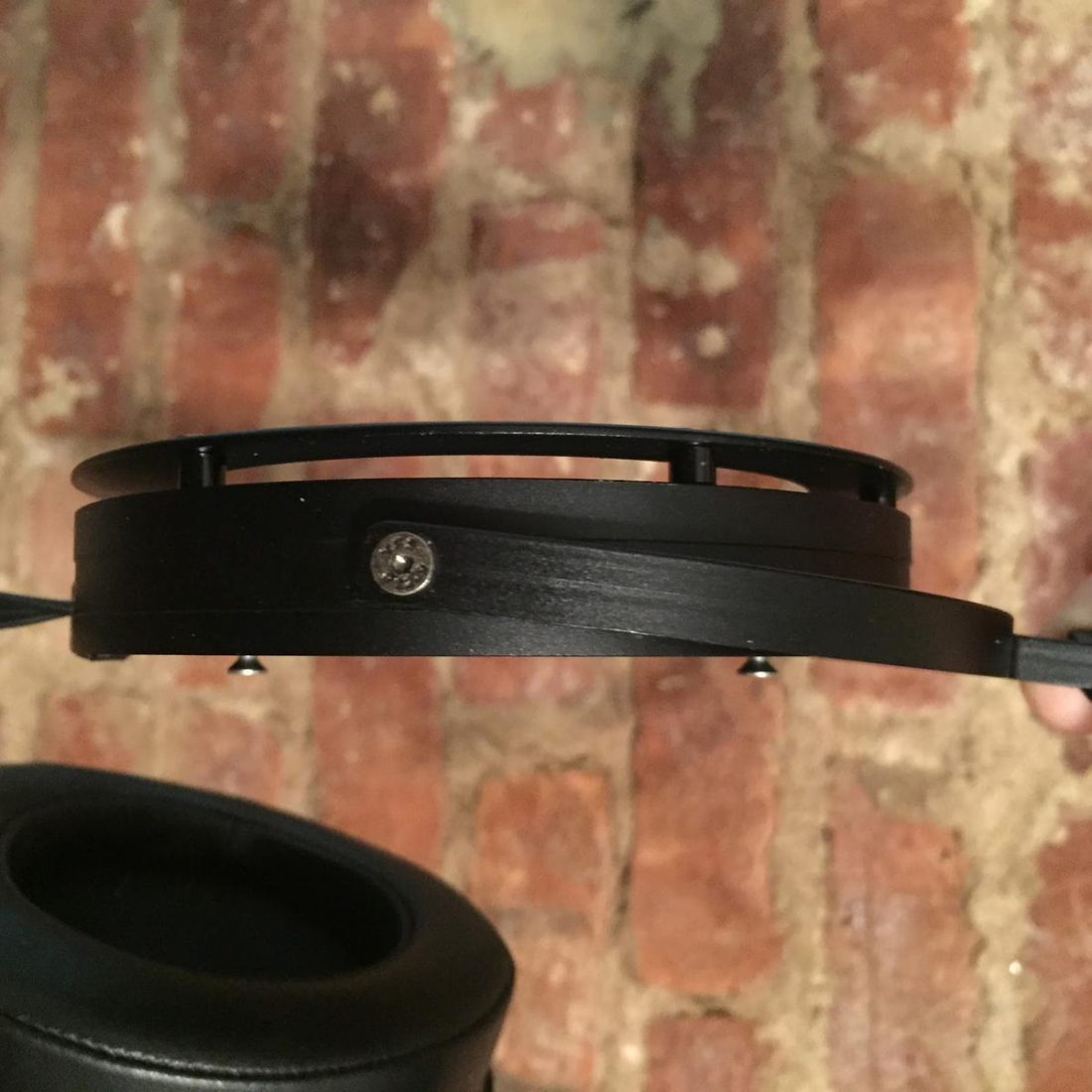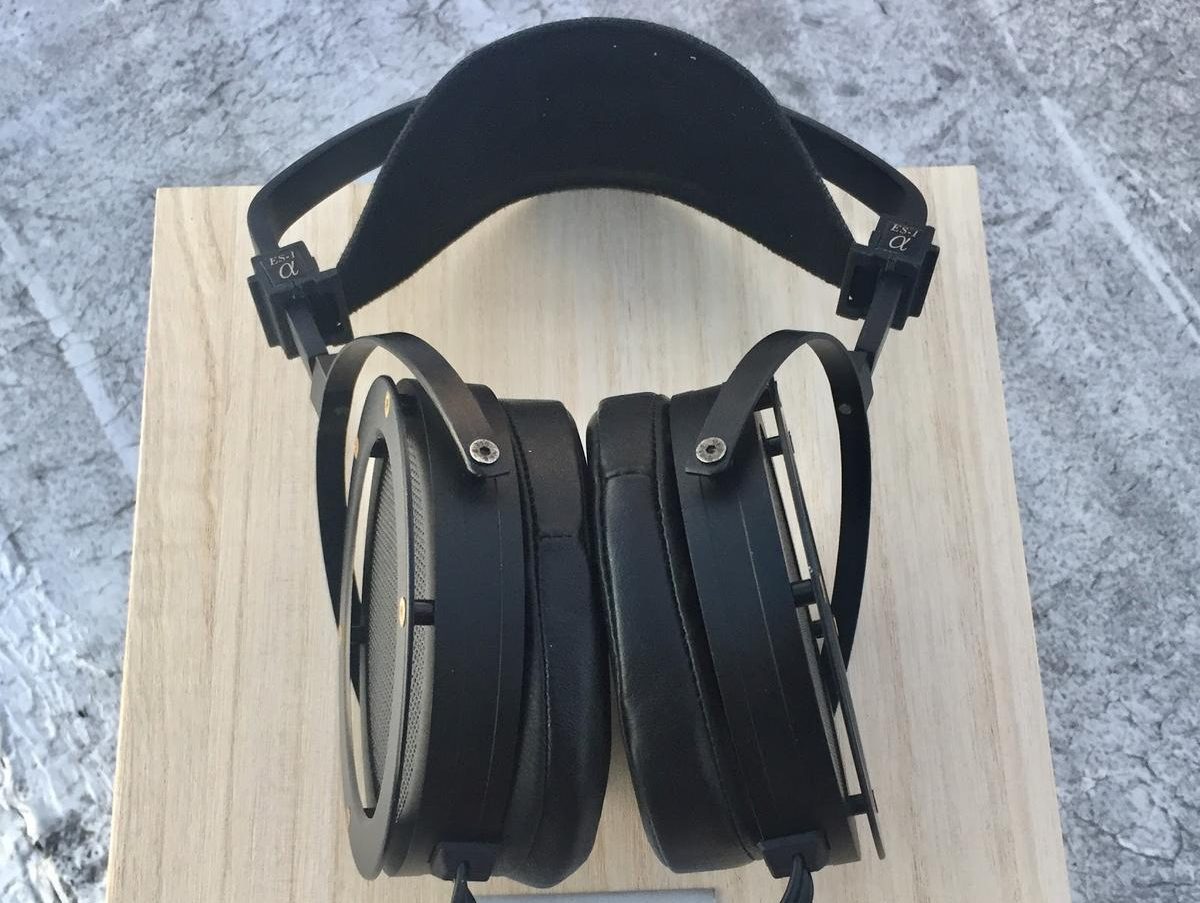The flagship product of Hong Kong’s boutique electrostatic headphone manufacturer ES Lab is an homage to the Stax SR-Omega – and it’s a lot of fun to listen to.
The state of affairs for your average enthusiast of electrostatic headphones is quite simple: in order to get a taste of that delicious ethereal transparency, the feeling of sound magically appearing in and around your head, you spend money. And not a trivial sum, either – electrostatic headphones can cost anywhere from a few hundred dollars to tens of thousands.
ES Lab’s Benson Wong knows a lot about electrostatic headphones. From building estat amps, to repairing a myriad of estats, including some that are quite rare, he’s an electrostat enthusiast through and through.
And recently, he’s started taking his experience in repairing and turned that into an enterprise of his own, with ES Lab. ES Lab only makes a couple products: the ES-1 alpha (ES-1a), originally released in December of 2019, which has its own drivers, and a recreation of the Stax SR-Sigma, which uses repurposed drivers from various Stax Lambda models.
- Smooth, resolving electrostat sound
- Wide-open soundstage with good imaging
- Smooth and delicate treble
- Impactful and well-extended bass
- Looks beautiful!
- Slightly shouty and uneven midrange
- Extremely quick decay can make things sound unnaturally dry
- Slightly heavy build
- Difficult to power
Although its drivers are original, the ES-1a also owes a fair bit to Japanese manufacturer Stax’s headphones. The design and sound is heavily inspired by Stax’s own SR-Omega, a defunct and exceedingly rare headphone model that was so costly to manufacture that it drove Stax to bankruptcy in the 1990s.
Currently priced at HK$12,500, or about USD$1,600, the ES-1a is no gimme; however, given what you’re getting, I think the price is quite fair. In comparison, the Stax SR-007 is USD$2,100, and the SR-009 is USD$3,700. I believe that the ES-1a plays at a higher level of performance than the current Stax Lambdas, and is about at the same level as the aforementioned SR-007 and SR-009.
Since the ES-1a is a newcomer to the high-end electrostat scene, the question becomes: can it play with the big boys? Fortunately for it, I find the answer to be a resounding yes. Coming from a small and relatively inexperienced manufacturer, the ES-1a is a big surprise.

Technical Specification
While the ES-1a is somewhat similar to the SR-Omega visually and in its frequency response, the driver technology is pretty different. While the Omega uses mesh stators, the ES-1a uses more traditional, albeit extremely thin, copper stators.
The reason for this is pretty simple: the mesh stators of the SR-Omega are exceedingly difficult and expensive to manufacture. They were enough to drive Stax out of business, and it’d probably be too much for an independent manufacturer to handle.
Instead, Benson said, he turned to a prototype version of the SR-Omega that he had the opportunity to repair. As a result, Benson believes that the ES-1a approaches the original Omega and even surpasses it in some respects, like bass impact. Nonetheless, it should be noted that it is not a recreation of the Omega.
Unfortunately, due to the one-man-operation nature of ES Lab, Benson wasn’t able to provide me with a full list of specs. Notably, they lack impedance measurements at this time. Here is what they do have:
- Driver type: push-pull electrostatic
- Sensitivity: 95 dB / 100 V r.m.s. @ 1kHz
- Capacitance: 105 pF w/ cable
- Weight: 500 g
Build

I won’t mince words: the ES-1a is, to me, a very attractive headphone.
It’s not perfect, of course: it’s a boutique headphone, and so it’s not perfect. In particular, I noticed the sliders on the headband were a bit unrefined in appearance, with some rough edges and slight misalignments.
But overall, it looks very good. They are obviously inspired by the original SR-Omega, which are very attractive in their own right. The most obvious visual reference is the five brass screws on the outside, which hold the outer ring onto the earcups. The outer ring is replaceable, with an aluminum one and a wood one included with the headphone, though I left the aluminum one because I liked the appearance better.
Except for the headband, these headphones are made out of solid aluminum, and as such they are pretty heavy, especially when compared with the comparable models from Stax. That doesn’t get my goat.
I also enjoy how the construction is held together with a seemingly endless amount of screws. Electrostatic headphones are very fragile and no one, least of all I, would ever recommend trying to tamper with them as an inexperienced user. But it’s comforting nonetheless to know that the headphones were made to be fixed easily.
The headphones include two sets of earpads: one with fabric, and one without. The ones with fabric are called the “dark earpads,” and almost everyone who’s used the headphones express a preference for them; the neutral earpads are bass-light and shouty by comparison.
While the earpads are not stiff, they are not the most plush earpads I’ve ever encountered, either. This is fine, and the headphones still sit pretty well on my head.
The only problem I’ve noticed is that the pads sometimes have trouble making a seal with my head, and that can affect the sound. Electrostats are very, very dependant on having a fully sealed front volume (i.e., the pocket of air between the driver and the ear must be fully contained) in order to achieve proper bass extension.
Functionally, what this means is that I can get very slight bass imbalance if one of the earpads isn’t sealing properly. Even a small difference in seal can throw the bass off slightly, so one has to be careful. But this isn’t by any means a dealbreaker for me.
Overall, the ES-1a get high marks from me on build and looks. They are very pretty, and they feel good to wear.
Sound

The ES-1a is resolving, airy, dynamic (at least, for an electrostat), and very, very fast.
Its speed may be its greatest strength. The ES-1a chews through music like a bat out of hell, rendering complex rhythms and dense textures totally, effortlessly intelligible. This is certainly one of the single fastest headphones I’ve heard – at least, under the $2,000 mark (challengers include the Stax SR-009 and RAAL SR1a).
The ES-1a is also bright and aggressive. It adopts a fairly typical electrostat tuning: the slightly sucked-out lower mids, a noticeable peak in the 1-2kHz range, and a lot of air (a frequency emphasis above 10kHz). However, unlike some other electrostats, it combines these characteristics with – to my ears – a slight bass emphasis that may have more to do with bass quality than quantity.
The tuning will be a downside for anyone who is not a fan of electrostatic headphones generally. While the SR-007 provides the tuning necessary to appeal to people who are not normally fans of estats, the ES-1a sounds exactly like an electrostat – i.e., slightly unnatural to me and many others.
The speed can also be a shortfall of the ES-1a, depending on your position. I don’t tend to mind “unnaturally short decay,” as is evidenced by the fact that I use electrostats on the daily; however, with the ES-1a, the unnatural decay is manifestly obvious.
Sounds just don’t tend to retain their tails quite as well as I wish; they vanish too quickly, and everything becomes too neat and orderly, and it just strikes me as unnatural. This isn’t a problem I have with most estats, but the ES-1a proves itself the exception there too.
Anyone who loves, for example, the Stax SR-009s, should try the ES-1a. This does indeed get eerily close, closer than any Lambda, at just about half the price.
Bass

Upon firing up the ES-1a, the first thing that struck me was the bass. I don’t have a huge problem with electrostat bass, the way some do – the SR-007, for example, or even the Lambda Pro, have never struck me as particularly weak or deficient in the bass region.
But compared to them, the ES-1a is positively explosive, with a driving insistence to the bass that rivals some dynamic headphones. Given the right music, these things could kick your teeth out. If you’re a basshead, but for some reason you want electrostatic headphones, these are the ones to go for.
Of course, they’re not going to give you the kind of power that you could get from one of the Foster biodynamic headphones, like the Fostex TH900 or the E-MU Teak. But for an electrostatic headphone, these things are damn impressive, as far as slam goes.
When it comes to texture and detail, though, I find that the ES-1a suffers slightly. There’s a bit of boominess down there, though nothing on the level of your average dynamic headphones.
Compared to the SR-007, I think the ES-1a falls slightly behind in terms of detail. Sure, the 007 does tread slightly lighter in the bass region, but what you get in exchange is wonderful detail, clarity, and imaging in the bass region. (Of course, one would have to note that that’s only after closing the bass port on the modern SR-007 MK2, while the ES-1a has well-extended bass straight out of the box.)
In the end, it’s a bit of a trade-off. If you want great bass resolution, the SR-007 has it in spades; if you want energy and power, you’re better off with the ES-1a.
In any case, there’s hardly any roll-off to speak of with the ES-1a; it goes straight down to infrasonics, and you won’t miss anything at all that’s happening in the subbass.
Midrange
Lovers of electrostats – especially those by Stax – will know the typical “estat tuning”: a slightly recessed lower midrange that lends a light-bodied airiness to most sounds; a peak somewhere in the 1-2kHz range; and very slightly recessed upper mids above that.
This characterizes the tuning of every Stax Lambda, the original SR-Omega, the SR-009, and even, to a much lesser extent, the SR-007. True to its nature as an homage, the ES-1a retains the same general tuning.
What this means is that the ES-1a has a very, very light, airy character to its tone. While the SR-007 increases the general perception of the body by bringing down that 1-2kHz peak, the ES-1a sort of does it by providing extremely tactile bass. But this is a very light-sounding headphone; it certainly has the “estat ethereality.”
The result is that things sound very slightly unnatural, as the peak in the midrange adds a bit of a throaty bite to things that shouldn’t be there. The reduced body to instruments plays a role, too; they sound very airy and perhaps slightly fake, as you don’t get the harmonic richness that you would in real life.
Some have said that the SR-009 makes instruments sound like toys. I’m not sure if I agree, but I can hear what they mean with the ES-1a.
That peak also makes things a bit aggressive. More on this when we get to the soundstage, but suffice it to say that the midrange is quite forward, in typical Lambda fashion. On the other hand, the peak is only a few dB, and it’s not as wide as it is in most Lambdas, for example, so it doesn’t throw the timbre off quite as much as you might expect – except in particular cases.
But of course, all of this depends entirely on how you think about things. Headphones will never sound completely natural, and the ES-1a, to my mind, has many qualities that make up for its unnatural midrange tuning.
Treble

And so we get to the treble, the region that – to my mind – shows off some of the biggest strengths and the biggest weaknesses of electrostatic technology. While estats tend to have extremely clean treble, it can be slightly odd.
What I mean by clean is that estats lack the “grain” that is often there in dynamic and planar-magnetic headphones. By grain I mean that the sound in less resolving headphones is often very slightly distorted, such that sounds (especially in the treble) sound less fluid, as if it’s composed of individually-discernable grains. This is pretty easily audible when you’re comparing a good electrostatic headphone to a good dynamic.
The downside is that estats tend to have, to my ear, oddly-tuned treble. This has been a big problem with me and most Stax headphones: they lack sufficient lower treble, and have an exaggerated air region (around 9kHz and up, in the case of the SR-007).
The ES-1a does sort of have this characteristic, but it’s not quite as bad as on any Stax I’ve heard. The range of frequencies 9k and up are above neutral, but it’s less peaky than even the SR-007, and certainly less than any Lambda.
This may also be a result of the fact that the ES-1a has, to my ear, more upper mids than the SR-007, which helps even out the response and makes the upper treble less exaggerated by comparison.
In any case, I think the ES-1a takes the cake for best treble response among electrostatic headphones I’ve heard. I don’t find it overly bright or peaky, and it does everything quite well.
However, because of the speed, the treble may seem to lack some tactility. It’s like the headphones are whispering in your ear: cymbals, especially, sound shimmery, slightly lacking in body and realism. This is a problem with all electrostatic headphones I’ve heard, so it’s not like the ES-1a is unique in it, and it’s indeed better than almost all estats I’ve heard in this regard.
Soundstage, imaging, and other technicalities

In terms of soundstage size, the ES-1a provides a large-ish soundstage, for a pair of headphones. However, it’s not the kind of diffuse soundstage of the HD800. Sounds are vibrant and forward, but they seem to float around the head, with the furthest sounds seeming quite a bit further away than the closest ones.
In this, they stand in stark contrast with the SR-007, which positions even distant sounds relatively close to the head, and sounds like it has a “finite” soundstage. The SR-007, to my ears, has slightly better imaging, but the ES-1a is very close.
When it comes to orchestral recordings, the ES-1a sounds a bit better to my ears. While SR-007 has a tendency to sound slightly cramped when the recording explicitly demands a large soundstage, its intimacy makes it much more involving, to me, with most music.
Now: at the beginning of the “sound” section, I mentioned “speed,” and it’s that speed that’s essential to understand the presentation of sound that this headphone provides. The ES-1a is indeed very fast, probably somewhere between the SR-007 and the SR-009.
What this means is that instruments can sound sort of dry and ethereal. To my ears, the SR-007 manages a more realistic sound, with its slightly longer decay; while the ES-1a puts more space in between instruments. The instruments themselves sound a little lean and artificial as a result of the speed.
It’s hard to explain, exactly, but it’s like there’s too much space in the music. This is a problem that the ES-1a shares with the SR-009, and so I expect that many would find this totally acceptable, even a benefit, but to me, it’s a bit much, and I find myself preferring the presentation of the SR-007 overall.
I also find the SR-007 slightly more resolving, despite its slower speed.
In Conclusion

Perhaps you’ve demoed an SR-009 but find it just a touch too spacey and ethereal, and you want more tactile and dynamic ability? Or perhaps you don’t have the funds for an SR-009? Perhaps you’ve enjoyed some kind of Lambda and you want a slightly nicer headphone with similar general characteristics? Perhaps you’re simply very enthusiastic about the electrostatic sound?
In all these cases, the ES Lab ES-1a will be worth a look. It’s a beast of a headphone. The only catch is that it certainly will not work for all genres of music or all use cases – mostly due to its off midrange tone and blistering speed.
For the average listener, I would probably default to my typical recommendation of the SR-007, which has a more agreeable tone and slightly better resolution, to my ears. But the ES-1a absolutely provides something special that the SR-007 doesn’t have, in its open sound and its speed and aggression.
I frequently find the luxury headphone market frustrating, full as it is of vague and misleading claims, paid-off reviewers, and bunk pseudo-science. The ES Lab ES-1a is a labor of love: there’s no corners cut here, no price gouging, and no BS.
